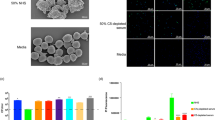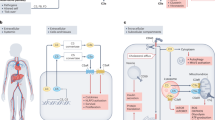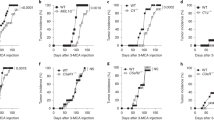Abstract
The human complement (C) system protects an individual against substances of nonself origin, including xenografts and microbial pathogens1. Human cells express C-regulatory proteins, CD46 and CD55, thereby circumventing attack by C3, a major effector of C (ref. 2). Nevertheless, certain malignant cells, particularly those undergoing apoptotic stress, can activate homologous C, overcoming the regulatory actions of CD46 and/or CD55 (ref. 3–5). The molecular mechanisms whereby malignant cells are tagged by homologous C3 remain largely unknown. We identified a novel gene product that converts human cells into targets for homologous complement. Only malignant cells and cell lines exposed to Fas or X-irradiation stimuli produced this protein, designated M161Ag, which was an unglycosylated 43-kDa protein. Analysis of cloned cDNAs indicated that this molecule was a secretory protein containing five amino acids encoded by TGA codons. Its functions were unique in that once secreted from the tumor cells, it bound back to the surface of these cells and activated homologous complement (C3) via the alternative pathway, allowing for C3 deposition on the membrane. This molecule may offer new insight into innate immunity; surveillance of tumor cells by complement is a common feature in the human immune system.
This is a preview of subscription content, access via your institution
Access options
Subscribe to this journal
Receive 12 print issues and online access
$209.00 per year
only $17.42 per issue
Buy this article
- Purchase on Springer Link
- Instant access to full article PDF
Prices may be subject to local taxes which are calculated during checkout
Similar content being viewed by others
References
Janeway, C.A., Jr. The immune system evolved to discriminate infectious nonself from noninfectious self. Immunol. Today 13, 11–16 (1992).
Atkinson, J.P. & Farris, T.C. Separation of self from nonself in the complement system. Immunol. Today 8, 212–213 (1987).
Ramos, O. F., Sarmay, G., Klein, E., Yefenof, E. & Gergely, J. Complement-dependent cellular cytotoxicity: Lymphoblastoid lines that activate complement component 3 (C3) and express C3 receptors have increased sensitivity to lymphocyte-mediated lysis in the presence of fresh human serum. Proc. Natl. Acad. Sci. USA 82, 5470–5474 (1985).
Seya, T., Hara, T., Matsumoto, M. & Akedo, H. Quantitative analysis of membrane cofactor protein (MCP) of complement: High expression of MCP on human leukemia cell lines, which is down-regulated during cell differentiation. J. Immunol. 145, 238–245 (1990).
Matsui, H., Tsuji, S., Nishimura, H. & Nagasawa, S. Activation of the alternative pathway of complement by apoptotic Jurkat cells. FEBS lett. 351, 419–422 (1994).
Matsumoto, M. & Seya, T. Homologous C3 deposition and homotypic cell adhesion in a human myeloid cell line, P39. Eur. J. Immunol. 23, 2270–2278 (1993).
Matsumoto, M., Yamashita, F., Iida, K., Tomita, M. & Seya, T. Purification and characterization of a human membrane protein that activates the alternative complement pathway and allows the deposition of homologous complement C3. J. Exp. Med. 181, 115–125 (1995).
Low, S.C. & Berry, M.J. Knowing when not to stop: Selenocysteine incorporation in eukaryotes. Trends Biochem. Sci. 21, 203–208 (1996).
Hill, K.E., Lloyd, R.S., Yang, J.-G., Read, R. & Burk, R.F. The cDNA for rat seleno-protein P contains 10 TGA codons in the open reading frame. J. Biol. Chem. 266, 10050–10053 (1991).
Dempsey, P.W., Allison, M.E.D., Akkaraju, S., Goodnow, C.C. & Fearon, D.T. C3d of complement as a molecular adjuvant: Bridging innate and acquired immunity. Science 271, 348–350 (1996).
Fearon, D.T. & Locksley, R.M. The instructive role of innate immunity in the acquired immune response. Science 272, 50–54 (1996).
Karp, C.L. et al. Mechanism of suppression of cell-mediated immunity by measles virus. Science 273, 228–231 (1996).
Holmskov, U., Malhotra, R., Sim, R.B. & Jensenius, J.C., Collectins: Collagenous C-type lectins of the innate immune defense system. Immunol. Today 15, 67–74 (1994).
Umemura, K., Yokota, Y., Kozutsumi, Y. & Kawasaki, T. A unique CD45 glyco-form recognized by the serum mannan-binding protein in immature thymocytes. J. Biol. Chem. 271, 4581–4584 (1996).
Gladyshev, V.N., Jeang, K.-T. & Stadtman, T.C., Selenocysteine, identified as the penultimate C-terminal residue in human T-cell thioredoxin reductase, corresponds to TGA in the human placental gene. Proc. Natl. Acad. Sci. USA 93, 6146–6151 (1996).
Itoh, N. et al. Cloning of an interleukin-3 receptor gene: A member of a distinct receptor gene family. Science 247, 324–327 (1990).
Matsumoto, M., Seya, T. & Nagasawa, S. Polymorphism and proteolytic fragments of granulocyte membrane cofactor protein (MCP, CD46) of complement. Biochem. J. 281, 493–499 (1992).
Kikkawa, S., Matsumoto, M. & Seya, T. Development of monoclonal antibodies against homologous C3 activating molecule, M161Ag. Jpn. Biochem. Soc. 68, 703 (1996) (Abstr.).
Iwai, K. et al. Preparation of a verifiable peptide-protein immunogen: Direction-controlled conjugation of a synthetic fragment of the monitor peptide with myoglobin and application for sequence analysis. Anal. Biochem. 171, 277–282 (1988).
Author information
Authors and Affiliations
Rights and permissions
About this article
Cite this article
Matsumoto, M., Takeda, J., Inoue, N. et al. A novel protein that participates in nonself discrimination of malignant cells by homologous complement. Nat Med 3, 1266–1270 (1997). https://doi.org/10.1038/nm1197-1266
Received:
Accepted:
Issue Date:
DOI: https://doi.org/10.1038/nm1197-1266
This article is cited by
-
Use of cancer-specific yeast-secreted in vivo biotinylated recombinant antibodies for serum biomarker discovery
Journal of Translational Medicine (2008)
-
Ascitic complement system in ovarian cancer
British Journal of Cancer (2005)
-
Mycoplasma origin of tumor cell protein
Nature Medicine (1998)
-
Reply to “Mycoplasma origin of tumor cell protein”
Nature Medicine (1998)



